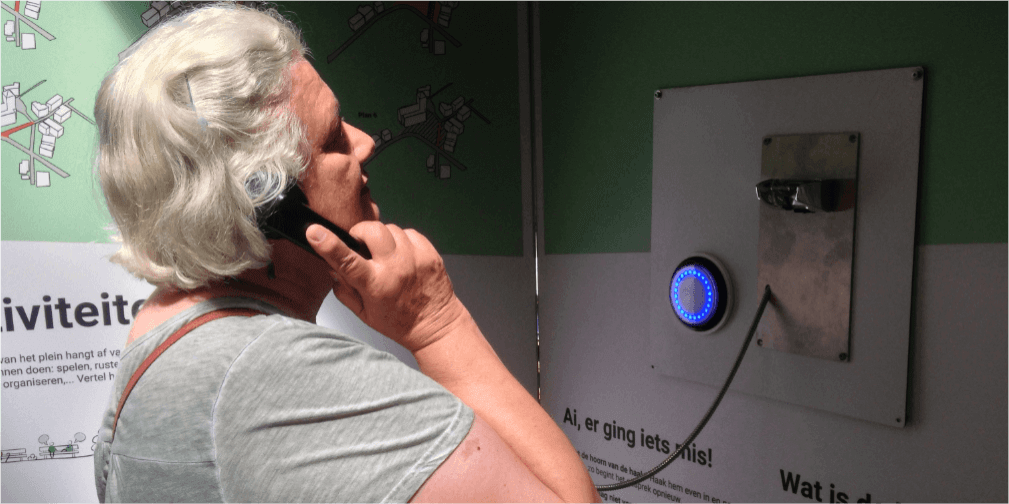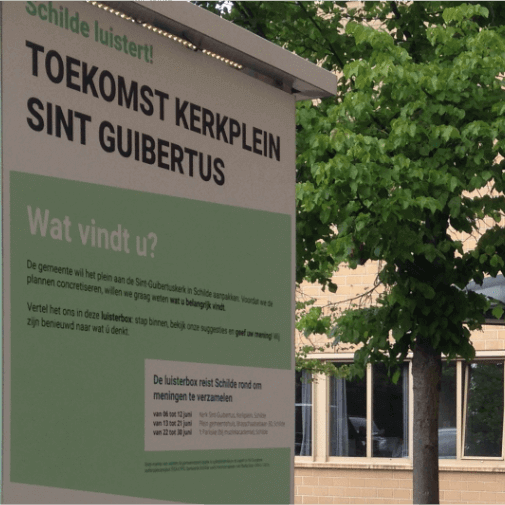Burgerparticipatie 2.0
06/15/2017
Gedurende de maand juni experimenteren we in gemeente Schilde met een nieuwe vorm van burgerparticipatie. Ons onderzoeksteam ontwierp hiervoor een 'participatiepaviljoen' (luisterbox, babbelbox of kortweg “Kott van Dott”). Het is een fysieke installatie die gedurende een aantal weken in een gemeente of stad geplaatst kan worden om meningen, ideeën, noden of wensen van burgers te verzamelen. Alle interactie gebeurt via natuurlijke taal, en wordt nadien digitaal geanalyseerd en verwerkt.

"Digitale participatie"
Binnen één van onze lopende onderzoeksprojecten, ITEA C3PO, gaan we op zoek naar hoe we steden en gemeenten kunnen ondersteunen in participatieprojecten. Onze focus ligt hierbij op het ontwerpen van methodes om grote groepen mensen op verschillende opeenvolgende tijdstippen in een cocreatief traject te betrekken. We zoeken specifiek naar alternatieven voor de typische 'standaard' enquêtes, met als doel te komen tot meer 'rijke' inzichten op basis van kwalitatieve data.
Wat ons opviel toen we dit project startten was dat veel organisaties inzetten op digitale burgerparticipatie. Dit komt, in veel gevallen, neer op een online platform waarop vragen gesteld en/of ideeën gepost kunnen worden. Hoewel dit een boeiende evolutie is, werd het ook meteen duidelijk dat deze nieuwe vormen van burgerparticipatie maar een beperkt segment van de bevolking bereiken. Onze doelstelling binnen het lopende onderzoeksproject is om nieuwe vormen van participatie aan te bieden zodat ze een zo breed mogelijk deel van de bevolking aanspreken én bereiken.


Schilde luistert
Gedurende de maand juni 2017 loopt het eerste experiment, in samenwerking met de gemeente Schilde. Studio Dott nam het initiatief om hiervoor een participatiepaviljoen te ontwerpen, wat tot stand kwam in samenwerking met Christophe VG, Cropland, Solution Group, Orange en CitizenLab.
Met dit eerste traject werken we rond het kerkplein in de gemeente. Voor er plannen voor het te vernieuwen plein ontworpen worden, vragen we aan de burgers wat zij nodig, leuk, aangenaam en zinvol achten. Met de input van de omwonenden en andere inwoners kan de gemeente Schilde het pakket van eisen voor het plein verfijnen en finaliseren.
We werken met een gelaagd systeem om dit mogelijk te maken. Het participatiepaviljoen houdt halt op 3 plekken in de gemeente. In het paviljoen presenteren we verschillende thema's die relevant zijn voor de ontwikkeling van het plein (mobiliteit, sfeer, activiteiten en inrichting). Inwoners kunnen hun idee of mening delen via een digitaal geconnecteerde telefoonhoorn. We werken hier bewust enkel via stemberichten, om de interactie zo vertrouwd mogelijk te laten overkomen. Daarnaast is er een online participatieplatform, waar we dezelfde thema's aansnijden en waar burgers in dialoog kunnen treden met elkaar en met de gemeente.
Alle data wordt nadien digitaal verwerkt. De opgenomen gesprekken in het paviljoen worden anoniem verwerkt door computeralgoritmes. Het doel is op basis van deze analyse een uitspraak te kunnen doen over zowel de inhoud van de antwoorden (themaclusters, patronen, overkoepelende meningen,…) als over het sentiment van de antwoorden (woordgebruik, gevoelsuitdrukking,...)
"Met de luisterbox maken we digitale burgerparticipatie mogelijk voor iedereen."
Slimme steden #smartcities
Als ontwerpbureau geloven we heel sterk in het aangaan van constructieve dialogen met alle betrokken stakeholders. Binnen steden wordt steeds vaker technologie ingezet om die dialoog aan te gaan, maar vaak wordt de menselijke interactie met die technologie op de tweede plaats gezet.
Met het participatiepaviljoen hebben we de ambitie een digitaal geconnecteerde gemeente of stad te ondersteunen, waarbinnen de interactie met en tussen mensen op de eerste plaats komt, en waarbij geen digitale vaardigheden van de inwoners vereist zijn.
Urban participation 2.0
06/15/2017
Throughout June, we're experimenting with a new format to involve citizens in policy making. We're collaborating with the town of Schilde (near Antwerp, Belgium). For this experiment, our research team created a 'participation pavilion'. This physical installation is designed to be placed in public spaces of a city or municipality for a set amount of time. The goal of the installation is to collect opinions, ideas, needs and wishes of the citizens. All interaction is audio-based using natural speech, which gets digitally processed afterwards.

"Digital participation"
With the solutions developed during our ongoing research projectITEA C3PO, we aim to support cities and municipalities that want to organize regular participation and co-creation with large groups of stakeholders. These new ways of participation move beyond the classical survey format, and hence allow us to get 'rich' insights based on qualitative data gathering.
Before starting this project, we noticed the increase in attention and interest regarding citizen participation in urban settings. In many cases, this comes down to an online platform which collects survey responses and provides a place to post new ideas. This is an important step forward, but it is apparent that these novel types of online urban participation are limited to a specific segment of citizens. That triggered us to explore and enhance the ways in which urban policy makers can reach out to and involve a larger slice of citizens on a repeated and continuous basis.


Schilde is listening
Our first larger participation experiment started in June 2017, in collaboration with the municipality of Schilde, in the Antwerp region (Belgium). Studio Dott designed a 'participation pavilion', which was further developed in collaboration with Christophe VG, Cropland, Solution Group, Orange and CitizenLab.
The participation topic being addressed is the reconstruction of the square near the local church in Schilde. Using our participation pavilion, we wanted to present citizens with the opportunity to express their opinions and ideas to improve the square, in a way that it would be most appealing to all stakeholders involved.
To make this possible, we took a layered approach. Firstly, the participation pavilion travels through the municipality for a period of 3 weeks. In the pavilion, citizens are introduced to a variety of themes related to the square (mobility, activities, materialisation and atmosphere). By picking up a digitally connected handset, citizens get prompted with a question related to these themes and are able to express their opinion. We deliberately chose for an audio-only approach in order for the interaction to be as natural as possible. Secondly, an online participation platform was set up to run in parallel. On this web-based platform, we present the same themes as in the pavilion and invite citizens to discuss them.
After this period of 3 weeks, all captured data gets processed and interpreted in a digital way. The recorded voice fragments get processed anonymously by computer algorithms. Eventually, the outcome of the analysis will shed light on the content (topical clusters, overarching opinions,...) and on the sentiment of the answers received (use of words, expressed feelings,...)
“Using the participation pavilion, we open up digital urban participation for everyone.”
#SmartCities
It’s Studio Dott’s strong belief that cities and municipalities should frequently and continuously engage in a constructive dialog with all involved stakeholders. Within an urban context, we notice that technology is increasingly being applied to facilitate this dialog, but also results in an increased need to improve they way citizens can interact with these technologies.
Our participation pavilion provides a physical touchpoint in an urban environment, and aims to support digitally connected cities and municipalities by radically focusing on a citizen-centric approach.

